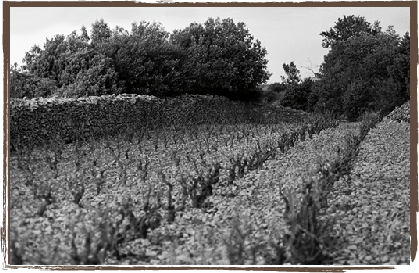

Lost in a desert of garrigues, bordered by walls of dry stones, Le Clos des Fées looks like a picture perfect postcard. The vines were planted with pickaxes, barely touching the layers of parent-limestone, in pockets of pure clay, zigzagging along impressive green oak trees. The stones were taken out of the vineyards one by one, by hand or pulled by a horse, then patiently and skilfully stacked by generations of wine growers from another era. They worked hard and long hours.
The village elders claim that as far back as they can remember, the tortured looking vines were always considered «old».
In the distance, the blue cliffs of Vingrau, almost shooting up vertically, have been around for far longer, whipped almost constantly by the winds from the Tramontane. At the foot of the Pyrenees the nearby Mediterranean Sea glistens. And if the fairies still gather and dance during the solstice, they do it here in this unique, different and mysterious place.
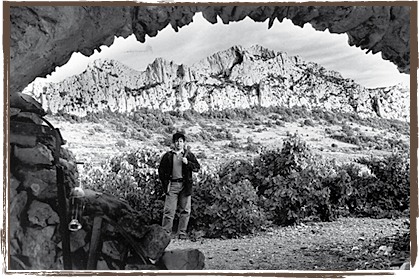

Without taking time to think, but just following my instinct, I chose this place to live fully my passion for wine. After starting as a young sommelier, then owner of a humble restaurant, an apprentice writer on wine and fine food, it was clear to me that when I reached a turning point in my life, I needed to cross over to the «producing» side to finally be able to learn – for lack of understanding – about all the stages a piece of dark wood goes through to give birth, years later, to an unforgettable nectar.
A few plots of old vines, a pair of secateurs, a weeding hoe and a second-hand back-pack sprayer; the only tools used by many growers in this region, far from the useless profusion of massive means and technology. That’s how I started, on a bright morning in 1997, without any money, or anything at stake, or great ambitions, but full of great dreams.
Quickly, the skin gets colored and tan, the hands cut and harden, the whole body suffers, tenses up and often stiffens. Now I know: the reality of daily life in the vineyard is far removed from the muffled atmosphere of star studded restaurants.


Advice, trials, the search for a style, and endless discussions, the first wines from the domain were made by the miracle of friendship, care and, above all, solidarity – A word that still holds meaning in the world of viticulture.
I often hesitate to talk about the first vintages of the Clos des Fées, for no one seems to believe me. We started in the back of a cellar provided by a friend, and were only able to destem once he finished his work. We had 4 tiny resin tanks, an old pump looking like it just came out of a second hand shop, cheese-cloths and the strength of our forceps to press the grapes and a rake to punch the cap. We had very few grapes, including a few meagre bunches picked in abandoned vineyards. We spent long hours selecting bays, logical, considering my limited experience. Therefore, we were often exhausted; some evenings even feeling a bit of despair, but we also had plenty of joy, passion and a good dose of madness. 1998 was a hot and dry vintage, but it gave us the opportunity to use our methods and ideas, new to this area, and create different wines which were well received by those who tasted them and showed us the path to follow: moving forward and being persistent.


A Miracle ! As early as April, the wine was sold En Primeur, as futures. Phew: without this, we wouldn’t have been able to go on, for lack of means. In any case, we still had to work, on the side, to earn our daily bread. Reassured, our bank granted an additional loan. It was the beginning of a long series…
This year was marked by turning the garage in our house into a cellar. We poured a concrete slab, installed three-phase current, moved the vats and bought two new ones, in stainless steel. Without any cooling system, we pumped fresh and pure water from the wash-house across the street, during the vinifications. When you lack the means, you better be creative…
We expended a bit our vineyard to 7 hectares (17.3 acres) in production, but only produced 15,000 bottles. We better get used to it, as low yields are part of our destiny. 75% of our wines are aged in new barrels, especially a new cuvee vinified in wooden half-puncheons. The number of cuvees grew. The success of the wines from the Domain exceeds our expectations and confirms our confidence that we are sitting on a huge terroir.
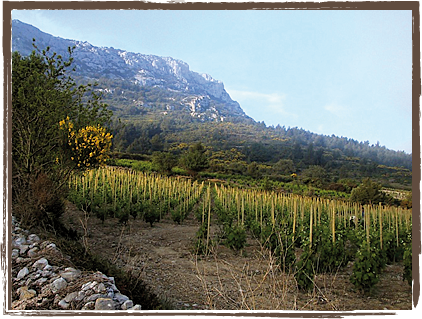

Nine hectares (22.24 acres) are now in production and we started our first planting: 1.5 hectare (3.7 acres) of quality Syrah grafted on selective root stock. The hillside plot is rough and steep. Will we ever have a tractor to plough such a plot? We will see. Buying one only takes a few minutes, while vines take years to grow and to take root. In the meantime, the motorized cultivator will have to do. We chose each individual pole, needed for bush pruning. People discretely came to check-out these strange poles. They make fun of them then, in no time, copied them.
During the harvest, the «Grand Cru» technique made the difference. Nothing can replace the human hand. Strangely, all the varietals ripened at the same time. We brought out the sorting table for the last time, without even realizing it… In the cellar, we used 2 small vats, better adapted to our low yields, and a peristaltic pump to preserves the quality of the must. We increased our number of barrels and the work conditions improved. The media started to write about the Clos des Fées. Still, the effect our wines had on people kept surprising us and amazing us.
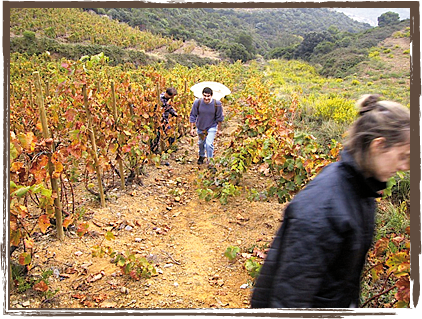

More than 1500 hours of work in the vineyards during the growing season allowed us to wait with serenity for the grapes to reach full ripeness. Serge joined us and brought the experience and instinct of a person born in this environment. A tractor was finally purchased, faster than planned, right on time to prepare the soil for our planting (1 hectare / 2.47 acres of syrah and half a hectare of Mourvèdre in Massale selection). We waved goodbye to our cultivator and Solo wheelbarrow. In fact, no one will miss them as they were hard to use. The motorized back-pack sprayers were, most likely, not going to disappear as they are necessary for vineyards located on steep slopes.
With now four full-time employees plus a few seasonal workers, for 10 hectares (24.71 acres) under production, we became part of the standard ratio for a property working towards quality. We were finally able to rent a small cellar in the village for our barrels and acquired our second peristaltic pump: too bad, we just had to keep the old Saxo… We kept taking more and more risk. Still, one thought kept us motivated: produce magical wines…
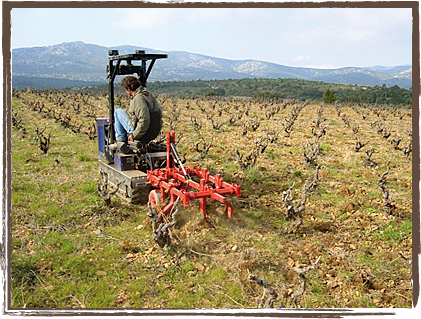

Vintages follow one another but all are different. 2002 will remain in our memory as a difficult vintage: with cloudy skies throughout the harvest, which began late as opposed to 2001. We had memorable skies, but also many questions and hesitations, and considered it our first difficult vintage. In hindsight, it was exciting and a good learning experience.
The need to respect our old vines encouraged us buy a hydrostatic tool with caterpillar tracks which enabled us to plough virtually everywhere. It was crucial that year to help evacuated deep water from the freshly ploughed soil. During fall, the seven permanent staff spent time carefully checking out the 15 hectares (37 acres) under production and tended the vines until… October 28.
The wines were magnificent, ripe and fresh, but revealed their explosive qualities during the aging process. The cooling unit we acquired allowed us to stop pumping water from the wash-house. It was the end of an era.
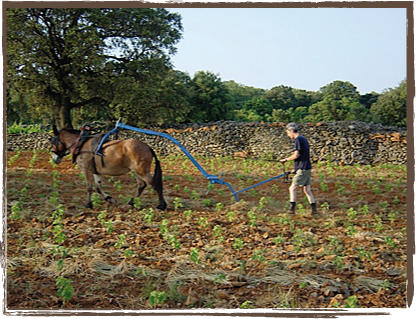

The sweltering hot vintage. Nothing exceptional in Vingrau. The vines here are used to dealing with hydrous stress. Varieties and root-stock have been selected over the centuries for this purpose. Two ploughings, at the end of the winter and early spring, using a tracked-vehicle and a mule-drawn plough, where regular tractors couldn’t pass, helped discard superficial rooting. This obliges the roots to dig deeper into the rocks to find water and nutrients, and so reveal the true nature of the Terroir.
Ripening shut down briefly in September, but patience paid-off and everything gradually fell back into place. We brought in some magnificent Carignan, picked late as we harvested until October 23rd. The stunning freshness proved the benefit of blending at an early stage and aging the varietals together. Bottled, the wines don’t show any hints of «cooked» fruit we feared. We planted a new plot with 12,000 vines per hectare. Unfortunately, the soil was not prepared enough, and after two years of struggle, we had to pull one row out of two. Nature called us back to order and taught us a lesson of humility.


The year of ripeness. The estate now covers 20 hectares (49.42 acres) of vines, incuding 5 (12.36 a) we were never be able to fit into our tiny ex-garage. So we only kept the best fruits. We were not worried as it was the way we wanted it: the vines are all treated like a «Grand Cru» and this year they were magnificent. Choices during the harvest were cornelian but quality was preserved. An old cellar in the village was re-opened, and its old concrete tanks repaired to produce «Les Sorcières». The quality of this cuvee has further improved thanks to the availability of grapes from our first Syrah plantings. Behind the caterpillar tractor, a highly sensitive tool caresses the trunks of the old vines which «Moustouille» (shiver with delight in Catalan) at being so well cared for. We planted a tiny amount of cabernet franc from cuttings as well as a few acres of Tempranillo: just to make sure that everyone can still call us crazy….
Great year for Fine Wine as well as truffles, which is rare occurrence.
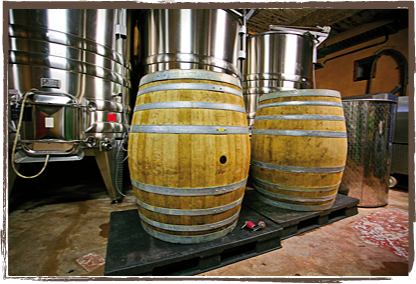

A great year, truly exceptional both for the estate and the wines.
In May, the leading French wine magazine, La Revue de Vin de France, rated us as «the N°1 estate in the Roussillon». This motivated the whole team to do even better… A damp winter led to a smaller numbers of bunches across all varietals and coulure hit several plots of Grenache. The summer was hot but spared us from heat-waves and drought. Thanks to two new air pumps we acquired we can now blow hot and cold air. Two new sprayers were delivered right on time, as the pressure from odium remained constant throughout the summer. The team is tight and did wonders in the vineyards during the green harvest blending speed and precision. The result was perfectly healthy grapes at harvest time, to the extent that, for the fourth year running, we didn’t need our sorting table. The vinification was easy. The wines are rich but with tension, focused and with lots of energy. The fruit flavors are explosive and complex. With exceptional tannins, the wines will cellar well and improve during aging. A year to be remembered.
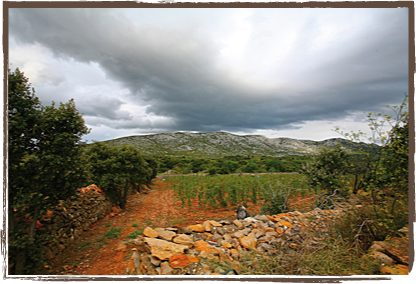

We realize, unknowingly, that we practice the Japanese «Kaizen» approach… A visiting friend explained its principle, based on «progressive and constant improvements of minute details, with the aim of satisfying the most demanding customer», in other word, «continuous improvement». Throughout the year we changed all the farming equipment, including our three tractors, as we prefer to adjust tools to our old vines rather than the other way around. On the road to excellence every detail counts… Our team has now grown to eight, and the vineyard surface now covers almost 30 hectares (74.13 acres), following the (unreasonable) acquisition of a hillside plot of old Grenache. It had been abandoned and the team struggled for over two months to save it, despite wind and bitter cold temperature. The winter was cold and wet; bud-burst came late, then it didn’t rain between May and mid-September. The harvest was exhausting and we had to take risks. We vinified slowly to extract gently, producing powerful and concentrated wines which revealed themselves during aging. A memorable year for boletus mushrooms (ceps).
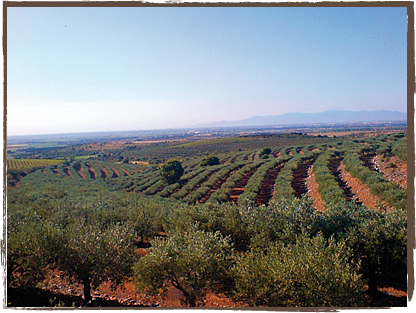

The windy year. At the very least, for 200 days. Wind from the sea or the cold and strong Tramontane, freezing your stomach in winter and making you crazy in summer. It was the first harvest of the new parcel of Syrah from the Granite soil in Lesquerde. The unusual name we chose will probably once more get us noticed. The wine is exceptional, and that’s all that matters. In March, when the team was barely recovering, we were called to save 30 hectares (74 acres) of vines and 40 (90 acres) of olive grove condemned to be pulled-up. Impossible.
We don’t have the means, financial, equipment or human. We take a look anyway and were struck by lightning. As the team rolled up its sleeves, we put our thinking caps on. Our banker supported us. With the help of the Safer, we are now tenant-farmers for the next two years. Will we succeed? Who knows, but the trees and the vines are saved. First crop of olives, to eat and making oil. The harvest was easy sunny and done in good spirits. The yeast was a bit lazy and the alcoholic fermentation ended in the spring; but the wines revealed themselves: creamy, sensual, full of fruit and silky tannins. In English we say «Pashmina tannins». We couldn’t have hoped for more to celebrate our tenth harvest.
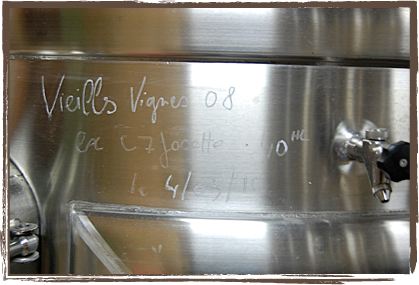

The «Sister Anne» year, waiting for water that never came. Mild winter, dry, with a few storms in the spring, perfect for budding. Beautiful grapes. And then four months of drought with grey skies, clouds ready to burst, with 15 to 20 days during the summer. But no rain, in spite of our prayers, invocations, dances and songs … Still, the vines remained green, even in the heart of summer, thanks to winds coming from the sea. We tried to integrate the Mas de la Chique, like «the boa from the Little Prince who had swallowed an elephant», with its 15,000 abandoned olive trees and vines. The rain came on September 11, like a gift sent by God, invigorating the thirsty vines and allowing us to harvest shiny grapes, black as ebony.
The vinification took place without any problems; the wines are sexy despite the tannins quite present. It is the first vintage of our new cuvee of Cabernet Franc, «un faune avec son fifre sous les oliviers sauvages» (a faun playing his flute under the wild olive trees). The 849 bottles produced were snapped up in five days. On the label, the faun will change every year and age with us. Tiny harvest of green olives, beautiful black Lucca.


This vintage made you understand the word humility. Along with tolerance, two major virtues according to Confusius… Cold winter with lots of rain in December. Memorable storm in February damaging the Clos des Fées’ big oak tree. Nice budding, homogenous flowering and a perfect spring. Lots of Tramontane during the summer, without a drop of rain between June and October. It was the year where controlling grass was essential for water was scarce… That put any doubt about the importance of plowing to rest. It is clear to me that it is a key component for producing great wines in times of global warming. If cultivating more than 100 plots often drives us crazy throughout the year, in this kind of vintage, we bless the heavens for having such a diversity of terroir, early, late; as it gives us such a broad palette of grapes available at harvest time. Great year for olives.
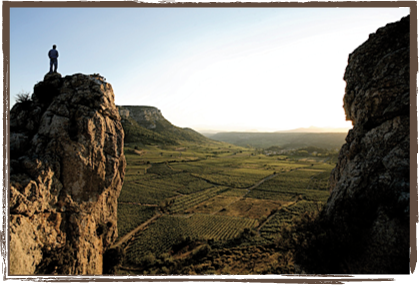

Dry and cold winter until March, with regular rain, but no noticeable excess. Dry summer, hot July, with a good shower on the 23rd. The month of August was very hot and therefore considered a «normal» year here: hot, dry. We he had to wait to reach optimum phenolic maturity. After twelve harvests, I’m no longer the inexperienced young man I was in the beginning; I learned to leave time to time. I now have a solid team and, for the first time, I feel like I can finally take some «distance», step back from the daily craziness to think about what to do or not to do, both are equally important. Slight changes in aging the Vieilles Vignes by transferring the black Grenache to small cement tanks. I increased the amount of Mourvèdre in the Clos des Fees for they looked so beautiful. A new cuvee, «Image Dérisoire» (ridiculous image), made with Tempranillo, blended by pure intuition with a bit of black Carignan, completes my trilogy of «strange» wines, my space for freedom.


What’s the vintage of the century? Exceptional quality. An impression of abundance. A feeling of «ease» throughout the growing cycle. Fun harvest, long and serene. The wines were good right from the time of running off, and will remain that way until the last day of their lives, probably for a very long time. If this is the definition of «vintage of the century», 2011 is one of those for us in Roussillon.
Rain in the spring, beautiful buds on all varieties, gorgeous flowers, cool summer, gray, but no rain, 60 days of good weather during the harvest, yet without a day over 30 degrees Celcius (86 f), cold nights, we had all the time needed to harvest and make wine with beautiful grapes. Mid-harvest, our tanks were full and realized that, perhaps, we won’t be able to bring everything in. The good weather allowed us to wait, plot by plot, for the last grape to be fully ripe. Concentration, finesse and especially, exceptional fruit. A dream year, we’ll talk about for a long time.


“Fortune favours the bold.” As a kid, I loved these old sayings. Growing up, I’m still amazed at how true they ring. After we had lunch among the olive trees, one of our customers told us, clearly tired of listening to us complaining about how we had so many plans but no money to make them come true with: “And what would you do with ten million euros?” Good question. Get started with the hillside that I’ve been dreaming of for ten years and that I’ve patiently reconstituted, plot by plot, all the while knowing I would never be able to afford to put it back into cultivation. The bank? Impossible. A financial backer? At the cost of our freedom. And what if we asked our customers? We ponder the idea, then give up, think about it again before backtracking at the thought of all the administrative difficulties and potential capital gains we would have to pay before even selling anything. Then during another lunch a name popped up, then another, some great advice, some letters, some ideas, a possibility, and at the end of 2011, a hundred customers became shareholders of the Clos des Fées. More than money, which would never be a problem anymore, our partners give us time, the kind of time that makes you both speed up and slow down. A new dynamic starts.
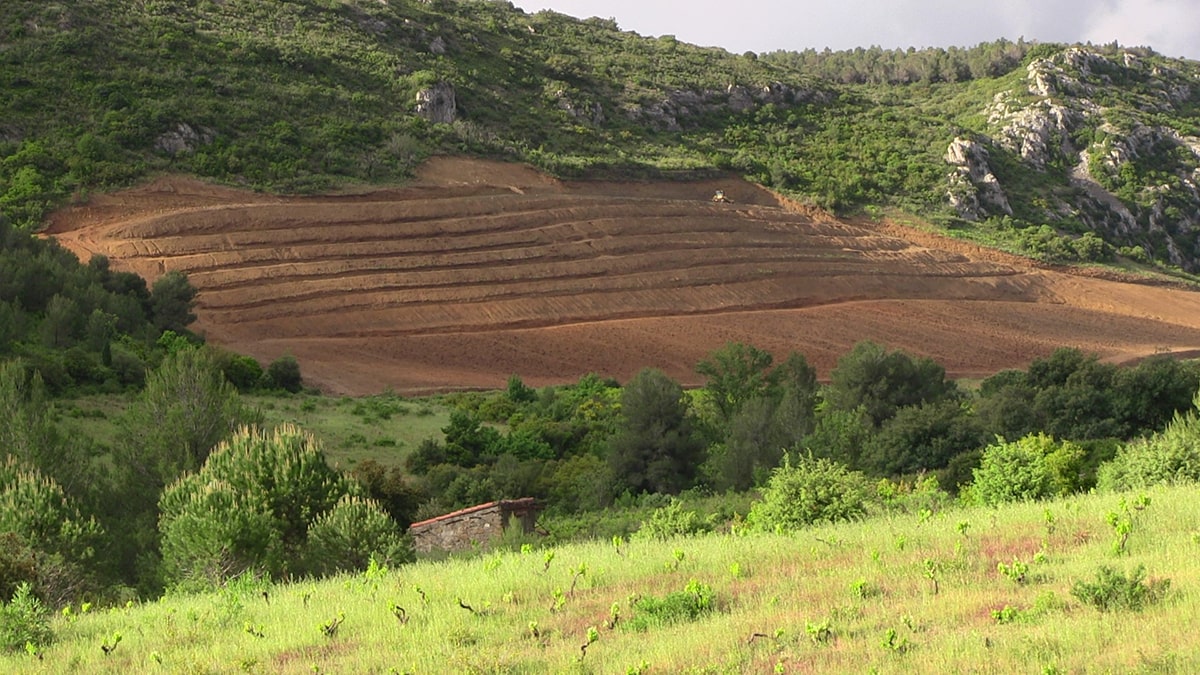

A terrible winter. Cold, grey. Three huge downpours of rain, two months apart, compromised our plans to plant the vines. We started rehabilitating an extreme hillside and made the questionable decision to plant it with pinot noir grapes… We cleared it, tore the old vines out, everything got washed away three times but the water showed us the way and we had to follow its steps. I was both full of hope and full of fear because I knew that, in ten years time, there might be a chance we would have to tear everything out again if it didn’t produce any results.
An icy Spring. Historical run-out on the grenache, especially on the later flowering plots up at 400 meters, which needed to be pruned later on. The conditions were then perfect except for the ones that neglected the famous “cuivre du quinze août” which stopped the mosaic mildew from growing and enabled the picking to start when the grapes reached optimum ripeness. Fifteen days late on the harvest, it was completed on 28th October, time when previous generations would stop.
A great vintage, glorious in Languedoc-Roussillon where the best French wines are made. We made the decision to bottle up an insane amount of jeroboams for future generations. A precise Clos des Fées, a wonderful Carignan, which will balance out the lack of Grenache. Charming right from the start with notes of black pepper, spices and raspberry jam, its liquorice finish complex most likely due to the cold September month.
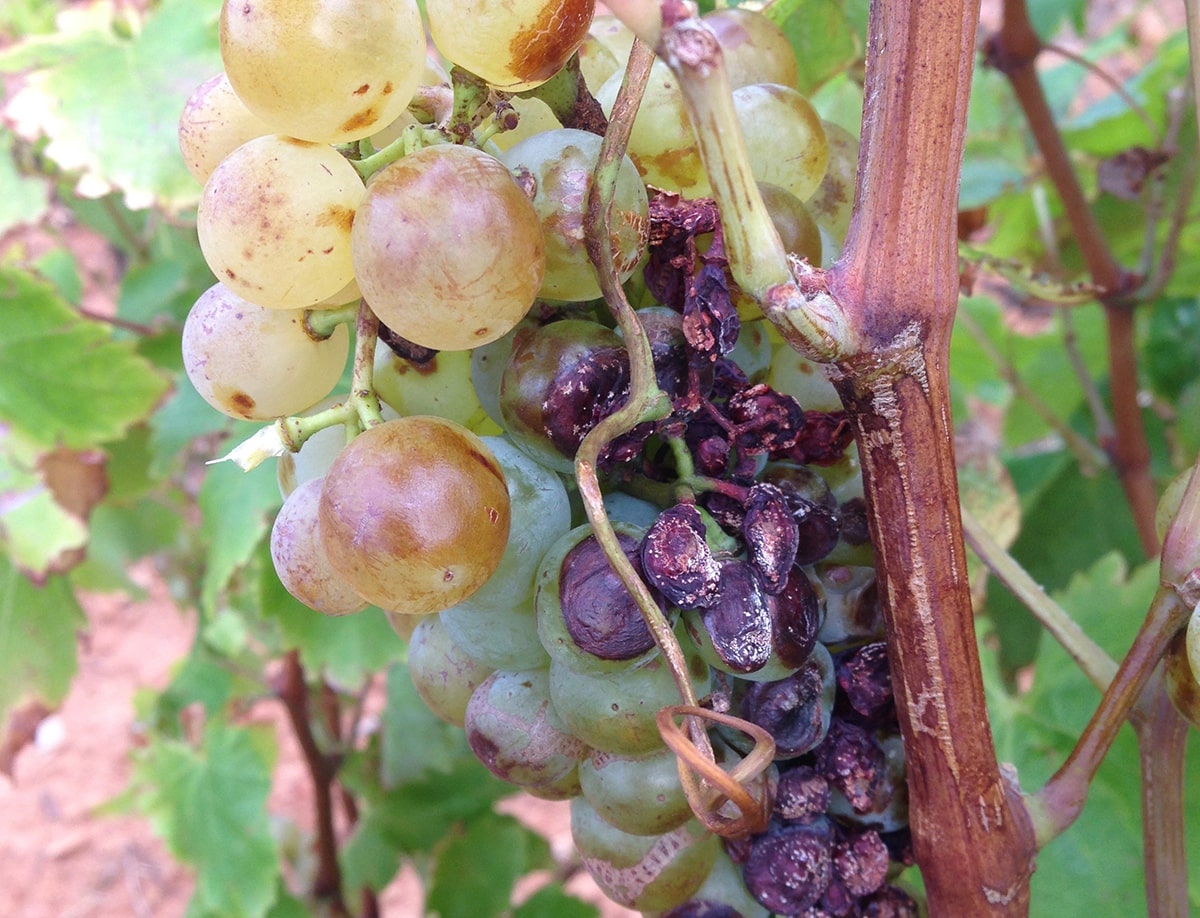

A cold, wet and late Spring. Nice buds pushing through, especially the grenache which blossomed really beautifully. It was hot in the Summer, but not scorching, and there was a permanent breeze which alternated between feeling very soft and very aggressive. We sprayed the vines in a very short timeframe, and it felt like the gods were punishing us by only making us care for them in the evening weekends. The plots were successfully harvested in perfect conditions but late, until they reached optimum maturity. We took a break to undergo the traditional “pre harvest grooming”, where every single grape is carefully inspected.
But then the Drosophilia Suzuki arrived… In only a matter of days, generation after generation, this destructive bug took over the entire region. “It’s coming down” became the motto. Only a handful of people admitted that year that the end of the harvesting season wasn’t decided by men but by a tiny little insect whose serrated rostrum enabled it to sting even healthy grapes. Thankfully we only had a dozen hectares left to harvest. We urgently asked all the olive pickers to focus on the vines. About thirty people were sorting out the grapes as they were still attached to the vines, getting rid of every single sick one. Right behind them was a team of pickers who cut what was left. Two hectares were not harvested. Clos des Fées is a rich wine with vibrant tannins. For a Petite Sibérie trimmed to last, its texture was incredible and its fruit astonishing.
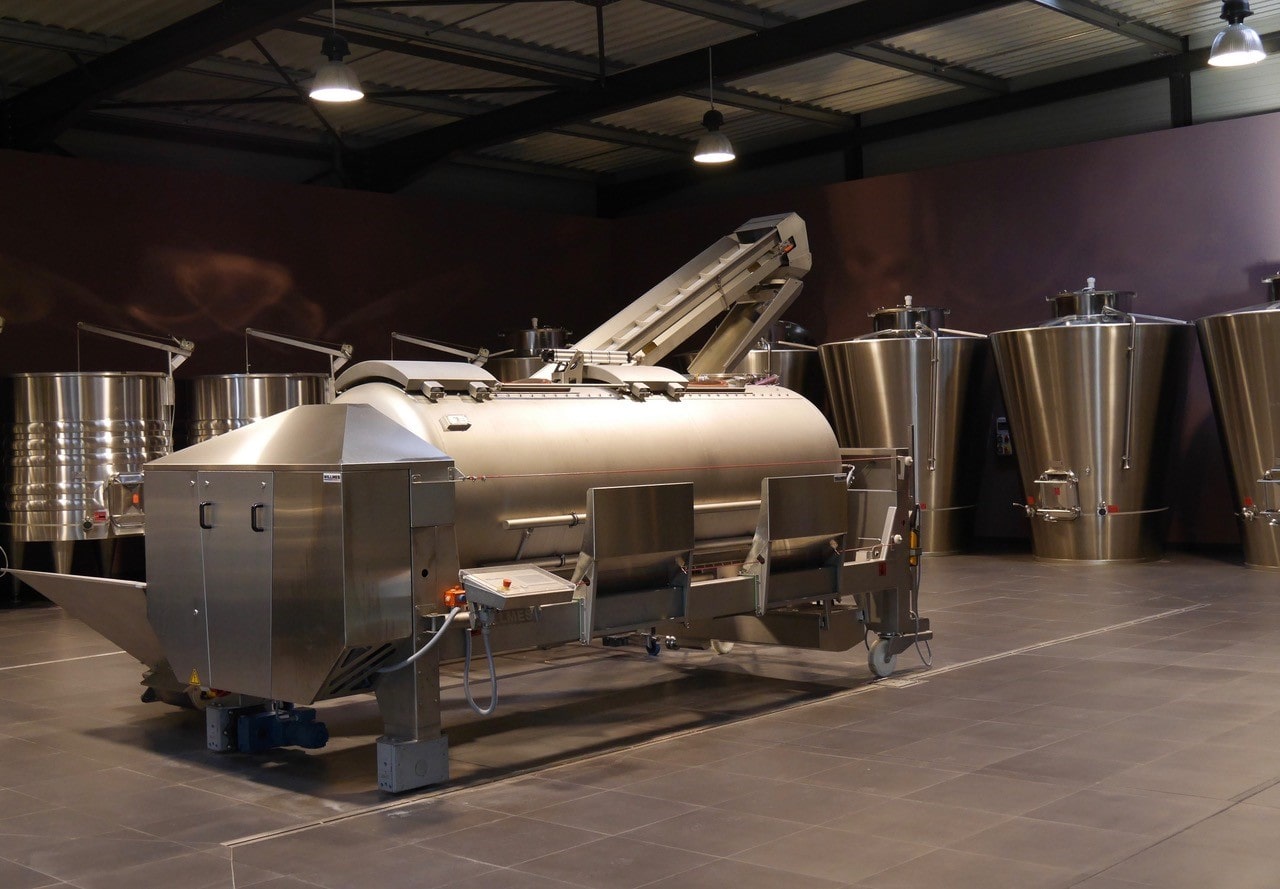

The year of transhumance. Leaving the garage was heartbreaking. We’d started making wine at home seventeen years before, able to smell its aromas from our bedroom, and to come down in the middle of a meal to check on the temperature.
Defacing the valley was unthinkable so we headed towards Rivesaltes. New cellar. It wouldn’t be the cellar deciding for me and constricting my choices, from now on I would be in charge. Using technology for wine is like using money in a game of poker, you need it to sit down and start playing, but it doesn’t necessarily mean you win. We had everything we needed to start with – a brand new wine press with refrigerated drains, inverted conical tanks, and a small barrel warehouse with air conditioning. It is a process run by the hand of man who, as fallible as he or she might be, will make the wine unique, unlike a machine which uses a recipe and makes it all the same. Some people make that mistake and it ends up costing them a great deal, but we won’t. I felt a little nervous remembering a conversation with Marcel Guigal about the yeast flora living in cellars, and how important it was to keep it alive. We moved all the tanks into the new cellar, hoping the yeast would survive.
A generous crop, a wonderful vintage with a unique velvety texture created by the clay-limehouse soil of Vingrau, topped with a glowing touch, an energy which makes it feel like the wine is fully alive. We obtained stunning ratings in the Wine Advocate with a score of 97/96/96/95/93/93. Full marks and the best rating of the whole of the Languedoc-Roussillon area.
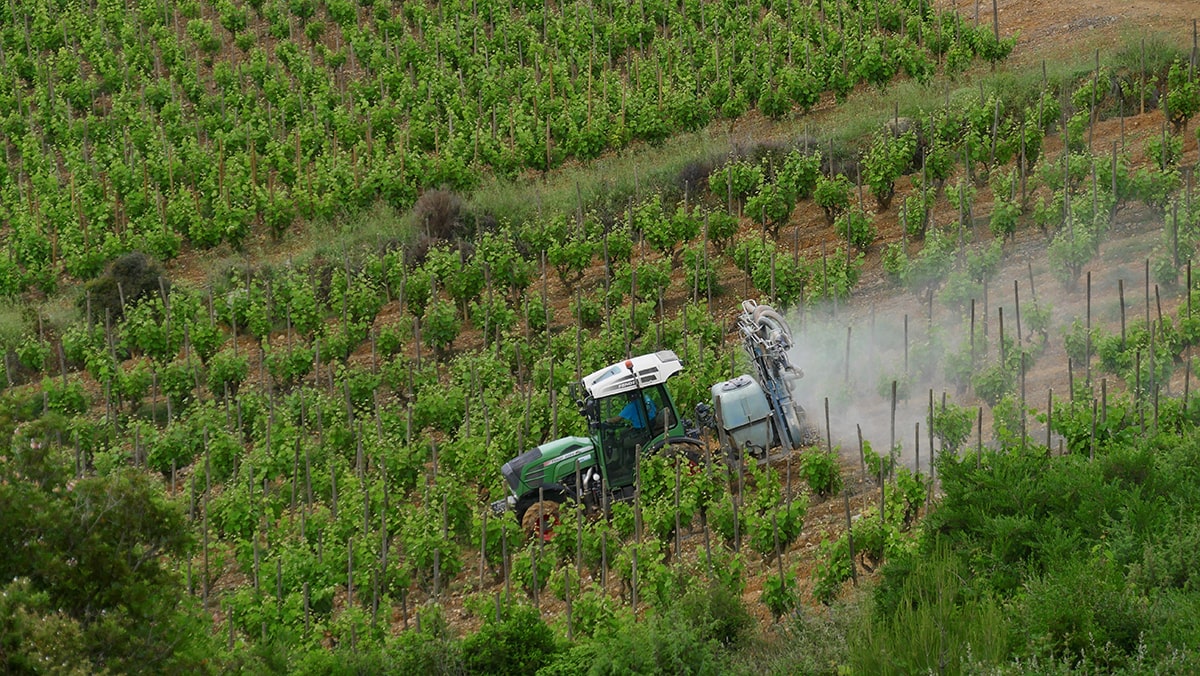

Our smallest harvest in volume since the regional council started recording numbers. A mild Autumn, a dry Winter, it barely rained in Spring and the grapes, although used to the semi-arid climate we have in Roussillon, prepared themselves for Summer, as if they had been “warned”: a weak growth and few leaves to avoid evapotranspiration. General run-out on Grenache following a heatwave while it blossomed. Less than 400ml for the whole year, it must have been the driest in the entire country that year.
A lot of energy, a lot of work, a lot of thinking done to adapt all year long: suited organic amendments, strengthening in trace element with a foliar fertilizer after examination of the petioles, a lot of light ploughing to bring air into the surface and create a ten centimeter zone which would use air as an insulator, in the same way I had seen people do it in Sicily.
Fast harvest, small grapes of course but full of sunshine; tanks only half-full but intense and delicious fruit. After six months of ageing and a tight selection, we had to admit that this was the smallest Clos des Fées crop. But I was very happy about the powerful blend, which turned out to be silky, sappy, deep and airy.
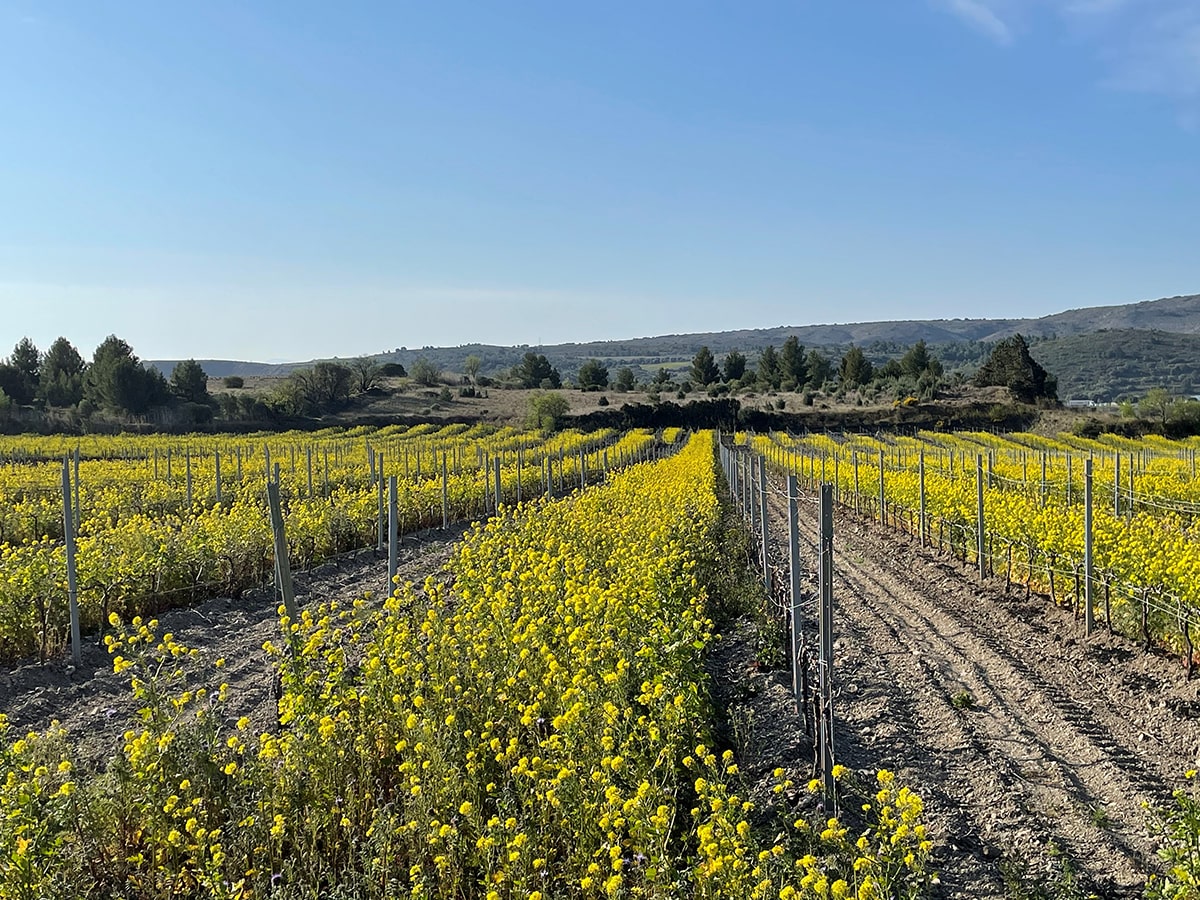

A complex and versatile vintage, quick and slow at once. Early picking in the plain (we started August 8th…), and late up on the hills (we finished on October 8th). A difficult harvest at times rushing and at times waiting. Two harvests in a way. When the first one was over, I was not thrilled about the grapes. Nice, nothing more though. An average vintage on the horizon? But fifteen days later we started working on the hillside. The cellar was immediately filled with a strong smell; we knew something was happening.
The strong frost we experienced in winter was probably the reason behind all of these differences. We bud-broke before the frost started and the vines followed a specific journey (it’s cold, we need to speed up); then after the frost they took on a different path (it’s cold, let’s slow down). Well maybe. The Mourvèdre ended more than two months after the first white ones. During the run-off, I looked for the wines I thought would be average; they’d disappeared, replaced with textured juices, full of aromas, dense bodies: it is a great vintage. Similar to the legendary 2007 one, which is still maturing.
We planted some Vermentino grapes in Espira de l’Agly, gently mocked by our neighbours, some of them even predicting nothing would grow. But I like talking to the elders, and someone once told me that here, twenty years ago, the wines were beautiful. He laughs best who laughs last.
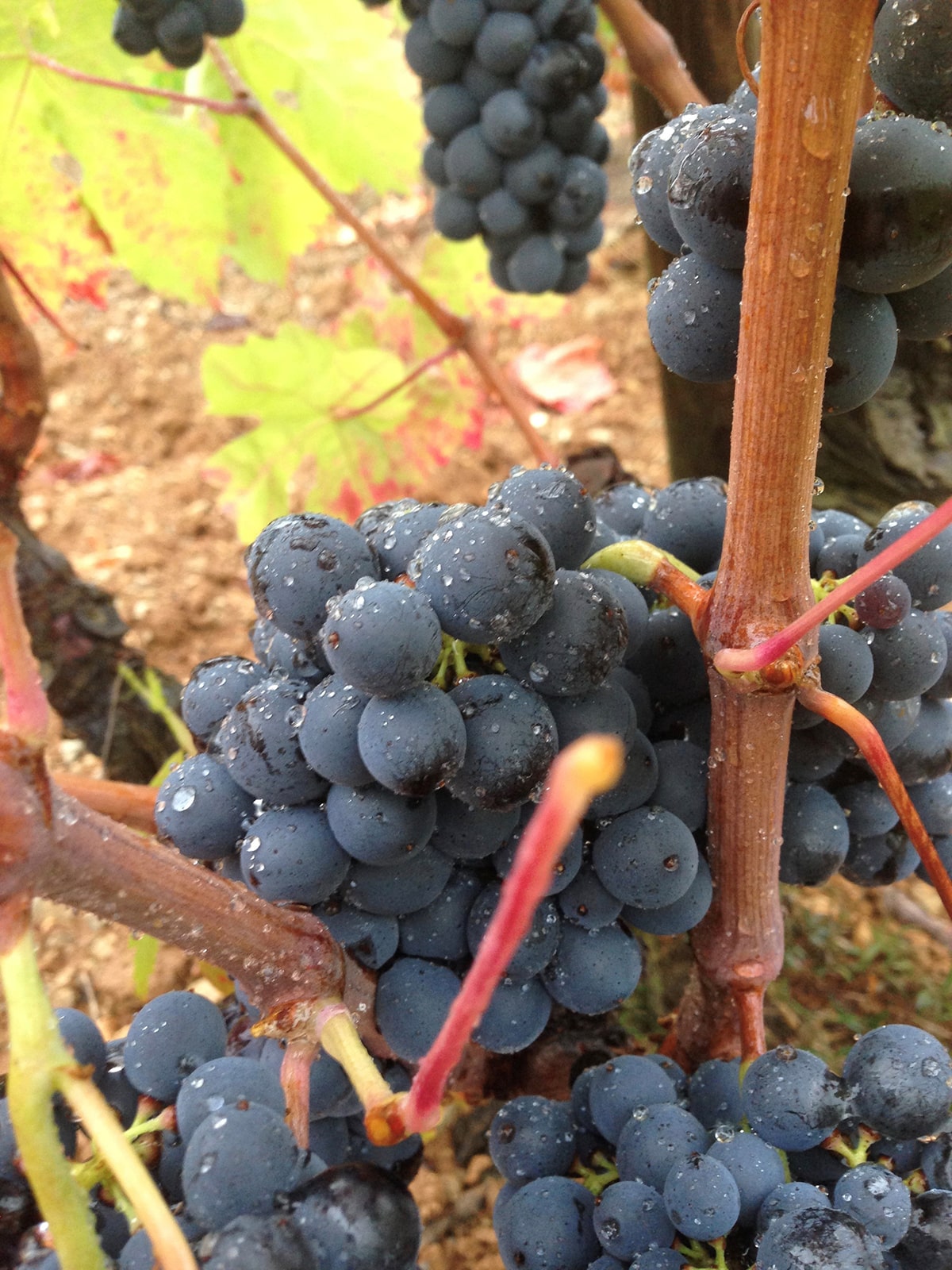

The powdery mildew year. Some people around here think it doesn’t exist. Climate has changed, rainy years are a thing of the past that old people talk about but no one listens to them. The problem with mildew is that, when you see it, it’s already too late.
Serge is no fool. He’s from the Rhône area and around there, people know it can destroy everything. The disease is “modelled”. Depending on each downpour of rain and temperatures, they know it’s coming.
Coincidentally at the end of winter, a journalist friend of mine told me to read this old book from 1930, How to fight powdery mildew on grape vines by Joseph Capus. I bought it, read it and followed the instructions: first spray the soil in infinitesimal amounts, and do it again after each downpour of rain or after each plowing. A year of battling, grateful to the weather after fifteen days when we were able to treat the soil with copper while in the rain, before it got completely soaked.
Six months of extreme drought followed. Neverending harvest until October 17th, the date when nature finally puts an end to it with a storm and 100mm of rain in a few hours – but the water turns out to be beneficial. Clos des Fées 2018 is particularly aromatic, and the only issue of its staggering balance would be to come after 2017 which was a real diamond. Time will decide.
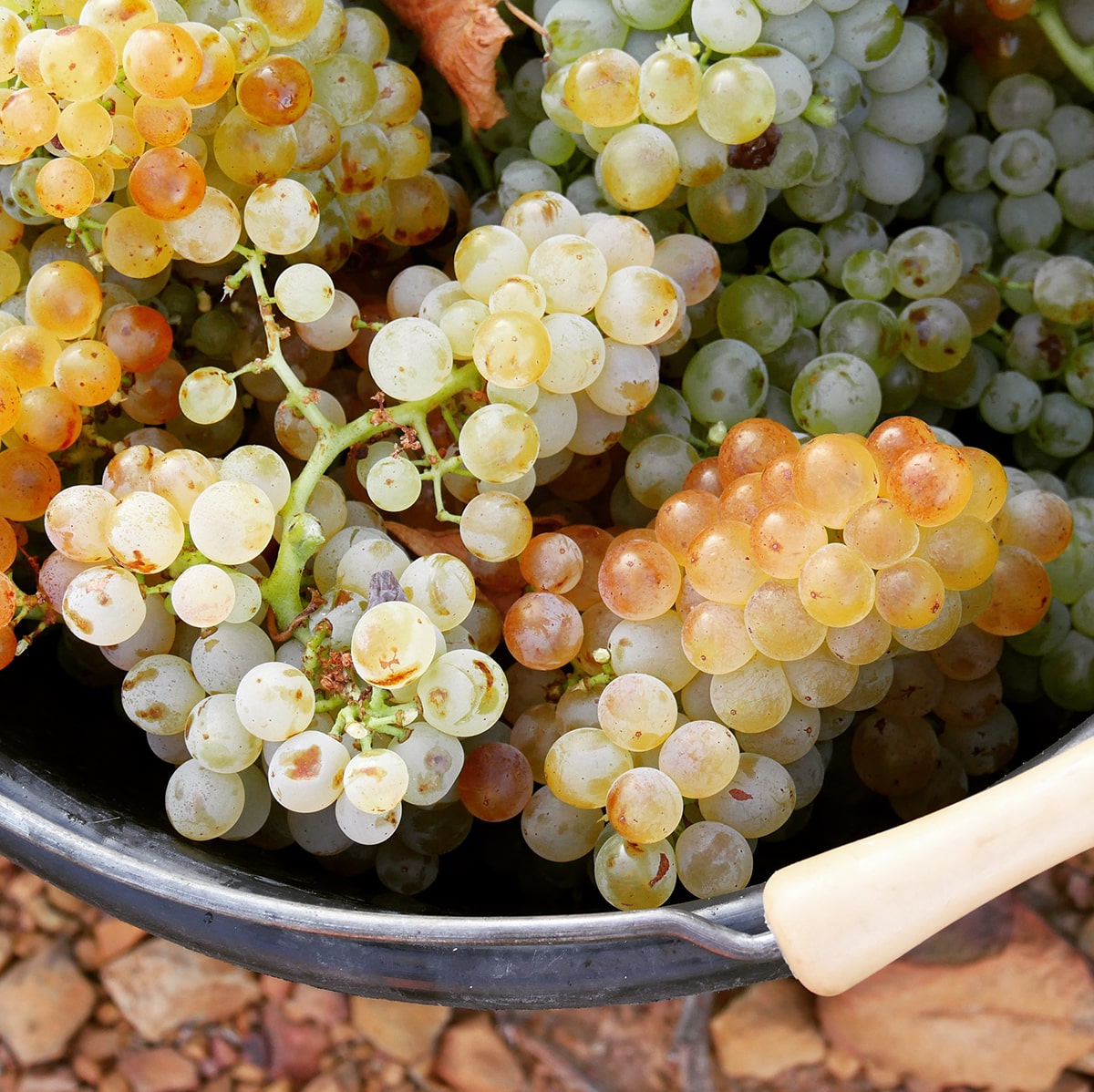

Fire among the vines. On June 28th, a serious heatwave along with burning sirocco winds destroyed the vines of those who didn’t look at the weather forecast and treated the vines with sulphur even up to the day before. It was 52 degrees in the Gard region. The ten-day weather forecast saved us. It got suddenly cold in May and then a scorching Summer followed. It was an early harvest in the plain because the vines came out and on September 12th, a magical rain started the ripening process again and slowed down the cycle creating a deep and long maturing.
Sumptuous Syrah, Mourvèdre to die for, the blends were obvious and the barrel warehouse was full for the first time after I blew the kitty on buying brand new barrels. From Spring onwards, the wines tasted wonderful, high quality, evident. I felt like singing. Clos des Fées is halfway somewhere between tautness and strength, like a petite Sibérie, as sharp as a knife, with an almost knotty finish. The vintage will outlast me.
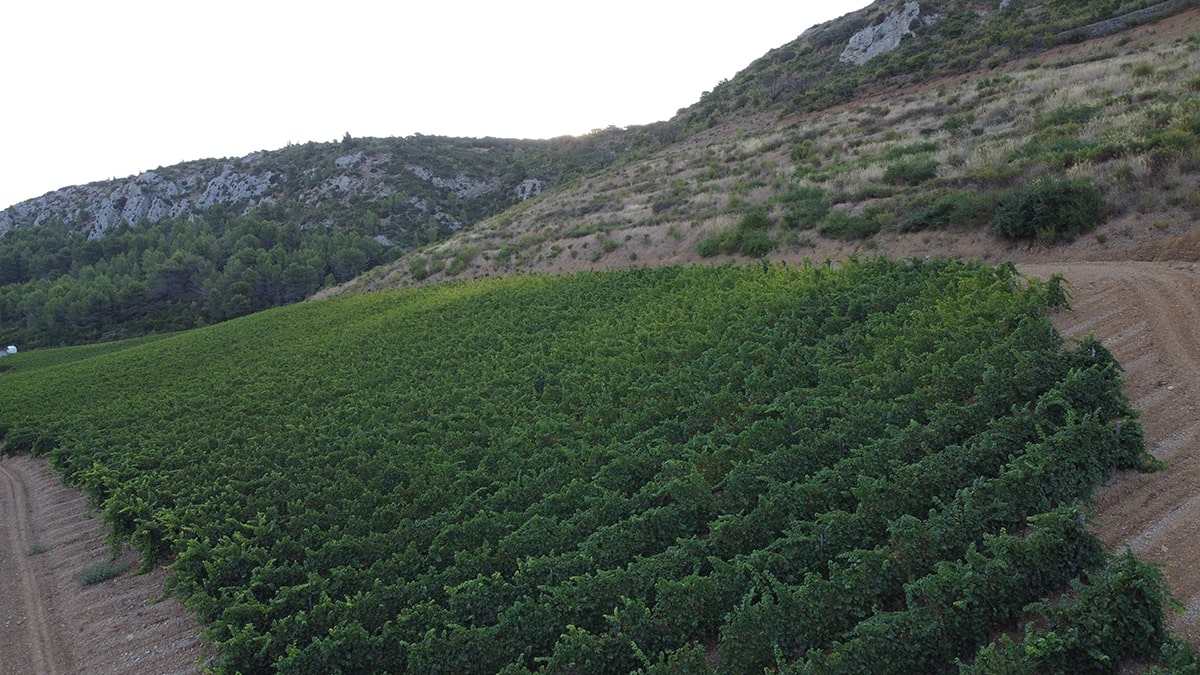

The year of Covid of course… In February, general lockdown. Worried about their families, our loyal tractor drivers thought about going back to Poland. It rained all the time and everything became very complicated. For ten days, we tried to find alternative solutions and saw a potential outcome on the horizon: losing 100% of the harvest. Fully supporting each other, we started working again – which felt more like battling – in a year where for the whole of Spring, the rain never stopped. We know this by now, the mildew years mean more work but still give a lot, especially as a dry and hot Summer allowed for a perfect harvest. The cellar kept up with it all, the harvest was intense, the Sorcières vintage is probably one of the best ones and the Domaine de la Chique is unequivocal. Very little of Clos des Fées, a drastic selection.
Meeting with Jean-Yves Bizot. We were both in awe of each other. Wooden tank, whole harvest, without any sulphur, no intervention. The pinot project is fruitful and the wine moves us, creating this “extra touch of soul” which we had hoped for, eight years before. The hillside has definitely changed a lot… A new future is taking shape.













